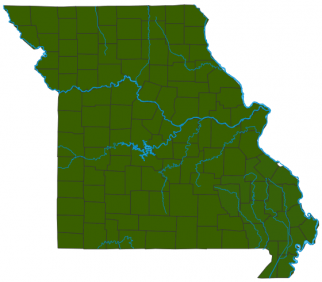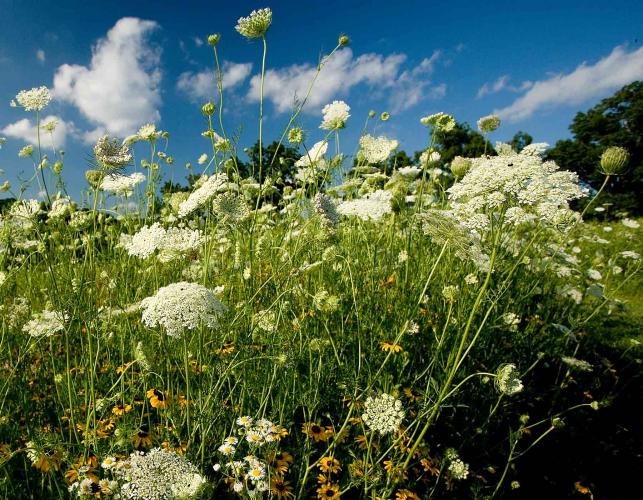
Queen Anne's lace is a biennial wildflower with branching stems. The flowers are minute, 5-petaled, white or rarely pinkish white, and arranged in large compound umbels (umbrella-shaped clusters). The central floret is usually purple. After blooming, the umbel withers and contracts, forming a bowl into which the seeds fall. Blooms May–October. The leaves are pinnately divided into straplike leaflets (twice-compound). A rosette of basal leaves is formed during the first year and overwinters. The flower stalk develops during the second growing season. The root is a stout taproot, much like a small carrot. The seeds are oblong and spiny.
Similar species: Missouri has several species in the carrot/parsley family with feathery, divided leaves and umbrella-shaped clusters of whitish flowers. One you should especially be aware of is common water hemlock, Cicuta maculata, which is extremely poisonous if ingested. Because water hemlock is extremely toxic, while other close relatives are considered edible, correct identification is critical for anyone wishing to eat wild edibles. Water hemlock's stems are usually streaked or spotted with purple, and usually hairless. It has doubly-compound leaves and the leaflets are large and rarely lobed. The veins that extend laterally from the leaflet midveins end mostly in the sinuses between the teeth (and not at the points of the teeth). If you are inexperienced with plant identification, it is best to consider all wild members of the carrot family as potentially fatally toxic.
Height: to 5 feet.

Statewide, though apparently uncommon in the Bootheel lowlands. Native of Eurasia.
Habitat and Conservation
Occurs in fields, pastures, banks of streams and rivers, tops of bluffs, glades, fencerows, roadsides, railroads, waste places, and open, disturbed areas. Introduced from Eurasia, this species has two subspecies: wild carrot (ssp. carota), which we consider a wildflower, and cultivated carrot (ssp. sativus), familiar from the grocery store. The root of the wild form is edible when young but soon becomes woody and unpleasant.
Human Connections
To many, this is a noxious weed that is difficult to control. Others use the fresh or dried flower stalks in floral arrangements. Cultivated carrot was developed long ago from this wild original. The plant creates many chemicals ranging from toxic to medicinal to skin-irritating.
Ecosystem Connections
A myth says the purplish flower at the center is a drop of blood shed when "Queen Anne" pricked herself while making the "lace." In reality, that small flower attracts insect pollinators. This nonnative plant competes against our native species. The seeds can stay viable for up to 5 years.
Ebony bugs (family Thyreocoridae) are tiny, shiny, black, beetle-like bugs that are almost often seen on flower clusters and immature seeds of members of the carrot or parsley family. Look for dozens of them feeding on the closed-up heads of spent Queen-Anne's lace flowers.





























